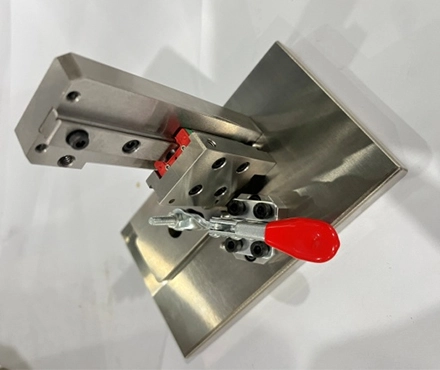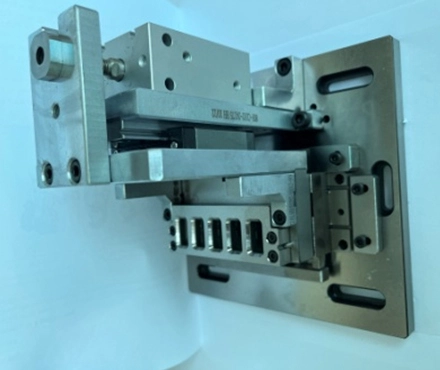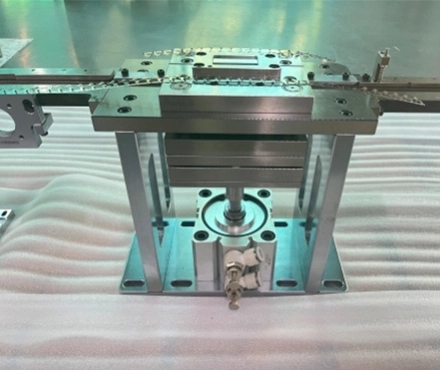Rapid prototyping parts are also applicable to the tooling fixture jig production. CNC turning fixture is used to fix the processing object in the mechanical manufacturing process, so that it occupies the correct position to accept the construction or detection of the device, clamping and positioning of the workpiece in the machining operations, to ensure that the workpiece can achieve precise positioning, to achieve accurate processing, rapid processing process requirements.
The CNC turning fixtures, as the important machining fixture components in AI machining products, are mainly used in the automotive industry, electronics manufacturing industry. In a broad sense, the device used to quickly, easily, and safely mount the workpiece in any process in the process can be called a fixture.
CNC turning fixture usually consists of positioning elements (to determine the correct position of the workpiece in the fixture), clamping devices, tool guidance elements (to determine the relative position of the tool and the workpiece or guide the direction of the tool), indexing devices (so that the workpiece in a single installation can complete several stations of processing, there are rotary indexing devices and linear moving indexing devices), connecting elements and clamping body (fixture base) and so on.
CNC turning fixtures are specialized tools designed to securely hold and position workpieces during the turning process on CNC lathes or turning centers. They are engineered with precision in mind, offering stable support to the workpiece to prevent movement or vibration that could compromise machining accuracy.
Clamping Mechanisms: One of the primary components of CNC turning fixtures is the clamping mechanism. This component securely holds the workpiece in place during machining. It may include jaws, collets, or other gripping devices that can be adjusted to accommodate various sizes and shapes of workpieces.
Base and Body: The base and body of the fixture provide a stable platform for mounting onto the CNC machine. They are often made from durable materials like steel or aluminum to withstand the forces and vibrations generated during machining.
Alignment Features: Precision alignment is critical in CNC machining. Turning fixtures include features such as alignment pins, V-blocks, or guide rails to ensure accurate positioning of the workpiece relative to the cutting tools.
Adjustment Mechanisms: To facilitate quick setup and adjustments, CNC turning fixtures may incorporate adjustable components. These allow machinists to fine-tune the orientation, height, or angle of the workpiece for optimal machining results.
Enhanced Precision: By minimizing workpiece movement and vibration, CNC turning fixtures contribute to achieving tight tolerances and precise geometries in machined parts.
Improved Efficiency: Standardizing setups with CNC turning fixtures reduces setup times and enhances overall machining efficiency, leading to increased productivity.
Versatility: CNC turning fixtures can accommodate a wide range of part sizes and shapes, making them versatile tools in diverse manufacturing environments.
Speed and Flexibility: One of the primary advantages of rapid prototyping manufacturing is its ability to accelerate the design iteration process. Engineers and designers can quickly create and modify tooling fixture and jig designs based on real-world testing and feedback, significantly reducing time-to-market for new products or production setups.
Cost Efficiency: Traditional methods of manufacturing tooling fixtures and jigs often involve extensive machining processes, which can be time-consuming and costly. Rapid prototyping minimizes material waste and labor costs associated with machining, particularly for low-volume or custom production runs.
Customization: Rapid prototyping allows for the production of highly customized tooling fixtures and jigs tailored to specific CNC turning applications. This customization ensures optimal performance and compatibility with diverse workpiece geometries and machining requirements.
Complex Geometries: Additive manufacturing techniques used in rapid prototyping can produce intricate geometries and internal structures that are challenging or impossible to achieve with traditional machining methods. This capability enhances the functionality and performance of tooling fixtures and jigs, improving overall manufacturing efficiency.
Quality Assurance: Modern rapid prototyping materials offer durability and mechanical properties comparable to traditional manufacturing materials. Prototypes produced through these methods undergo rigorous testing to validate design integrity and performance, ensuring high-quality standards in CNC turning operations.
While rapid prototyping offers substantial benefits, challenges such as material selection, surface finish requirements, and scalability for mass production remain areas of ongoing development. Advances in additive manufacturing technologies, including improved materials and enhanced process automation, are poised to address these challenges, further expanding the application of rapid prototyping in CNC turning tooling fixture and jig production.
Rapid prototyping has emerged as a transformative force in CNC turning tooling fixture and jig production, revolutionizing how manufacturers design, produce, and optimize tooling solutions. Its ability to enhance speed, flexibility, customization, and quality assurance underscores its indispensable role in modern manufacturing environments. As technology continues to evolve, the integration of rapid prototyping promises to drive innovation and efficiency, paving the way for enhanced productivity and competitiveness in global markets.



